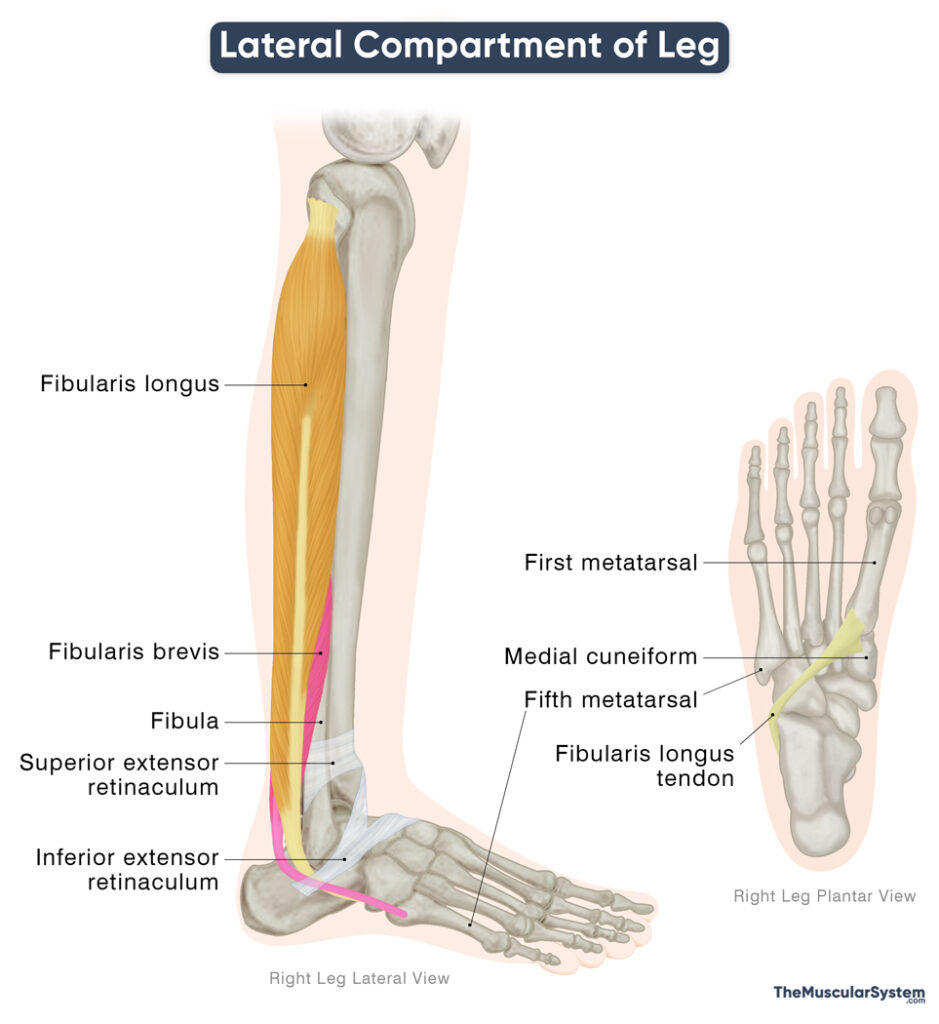Lateral Compartment of the Leg
Last updated:
15/10/2025Della Barnes, an MS Anatomy graduate, blends medical research with accessible writing, simplifying complex anatomy for a better understanding and appreciation of human anatomy.
The lateral compartment of the leg is one of the main fascial compartments of the lower limb. It is relatively narrow and contains two muscles on the outer side of the leg. These muscles are vital for everting and stabilizing the foot, and play a key role in the gait cycle.
The compartment is enclosed laterally by the deep fascia and medially by the fibula. It is separated from the anterior compartment by the anterior intermuscular septum and from the posterior compartment by the posterior intermuscular septum.
Muscles in the Lateral Compartment and Their Anatomy
There are two primary muscles in this compartment:
| Name | Origin | Insertion | Innervation | Blood Supply |
|---|---|---|---|---|
| Fibularis Longus | Head and lateral surface of upper two-thirds of fibula | Base of first metatarsal and medial cuneiform | Superficial fibular nerve (L5–S1) | Fibular artery |
| Fibularis Brevis | Lateral surface of lower two-thirds of fibula | Base of fifth metatarsal | Superficial fibular nerve (L5–S1) | Fibular artery |
Accessory Muscles
The fibularis muscles can show considerable variation, although the fibularis longus and fibularis brevis are consistently present in most individuals. In some cases, additional small accessory muscles are found. The most common of these is the peroneus quartus, a slender muscle that sometimes lies near the tendons of the extensor digitorum longus and may send a small tendon to the little toe.
Functions of the Lateral Leg Muscles
Eversion
The fibularis longus and brevis are the primary muscles for eversion of the foot, which means turning the sole outward. This movement helps distribute body weight more evenly across the foot during standing and walking. It also provides support to the lateral side of the ankle, protecting it against excessive inversion, the most common cause of ankle sprains.
Plantar Flexion
These muscles also contribute to plantarflexion, or pointing the toes downward. They act as secondary plantar flexors, assisting the gastrocnemius, soleus, and plantaris, the primary plantar flexors from the posterior compartment. This movement is essential for pushing the foot off the ground during walking and is also used in activities like standing on tiptoes or pressing a car pedal.
Since both fibularis longus and brevis originate from the fibula and share similar functions, they are collectively referred to as the fibularis (or peroneus) muscle group. The word “peroneus” comes from the Greek perónē, meaning “clasp” or “brooch,” a reference to the fibula’s slender form beside the larger tibia. The fibularis tertius, located in the anterior compartment, may also be included in this group since it originates from the fibula, inserts in the foot, and acts as an accessory muscle in foot eversion, though this muscle is not always present.
References
- Muscles in the Lateral Compartment of the Leg: TeachMeAnatomy.info
- Lateral Compartment of the Leg: Radiopaedia.org
- Fibular/Peroneal Muscles of the Leg: Kenhub.com
- Accessory Peroneal Muscles: Radiopaedia.org
- Anatomy, Bony Pelvis and Lower Limb: Leg Lateral Compartment: NCBI.NLM.NIH.gov
Della Barnes, an MS Anatomy graduate, blends medical research with accessible writing, simplifying complex anatomy for a better understanding and appreciation of human anatomy.
- Latest Posts by Della Barnes, MS Anatomy
-
Thyrohyoid
- -
Suprahyoid Muscles
- -
Geniohyoid
- All Posts






